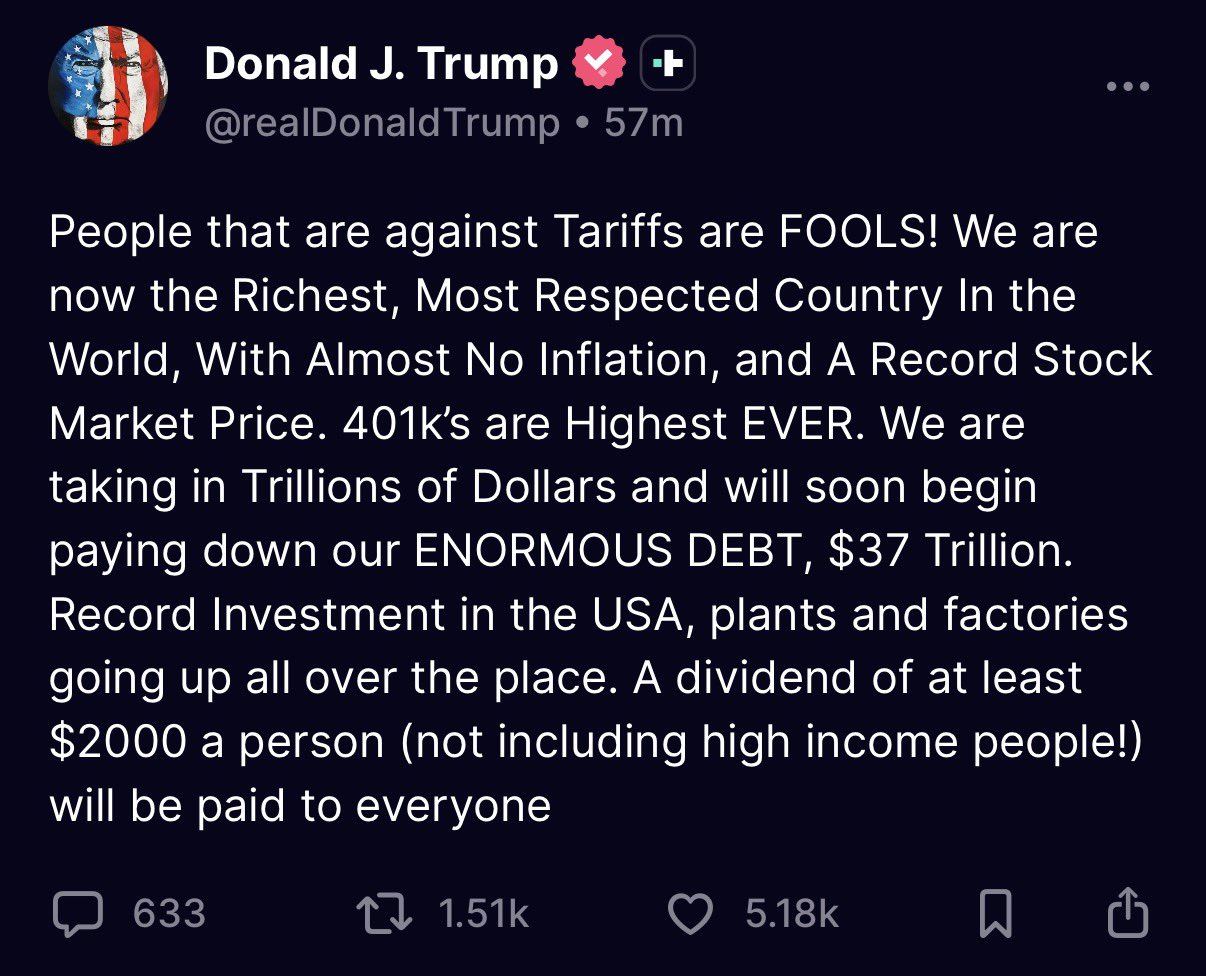Key Points
- President Donald Trump announced a plan to distribute at least $2,000 per person to most Americans, funded by tariff revenues.
- Depending on the definition of “high income”, it could cover about 85% of U.S. adults, but tariff collections currently total just $195 billion for fiscal 2025 – less than half of what such payments would require.
- Stimulus checks typically make inflation worse and would likely face legal challenges.
President Donald Trump said on Truth Social that his administration plans to send “a dividend of at least $2,000 per person” to most Americans, excluding high-income households. The payments would allegedly be financed entirely by tariffs collected on imported goods, rather than through borrowing or new taxes.

Trump described the initiative as both a payment to everyone and a tool to reduce the national debt, now approaching $37 trillion.
This post comes after a tough week for Trump at the Supreme Court, where his tariffs faced skepticism from multiple Supreme Court Justices.
Would you like to save this?
How The Tariff Dividend Checks Could Work
The actual post said, “A dividend of at least $2000 a person (not including high income people!) will be paid to everyone.“
According to Treasury data, the federal government has collected about $195 billion in tariff revenue during fiscal 2025, so far. Doing simple math, distributing $2,000 to roughly 85% of U.S. adults would require more than $400 billion, suggesting that the proposed payments would exceed current receipts by a wide margin.
Furthermore, if the tariffs are found unconstitutional at the Supreme Court, the government would be forced to issue refunds for all tariffs paid.
Economists have long warned that tariffs are taxes on U.S. importers and consumers, since companies importing have to pay and then simply pass those costs on through higher retail prices.
While the president has promoted tariffs as a way to strengthen domestic manufacturing and punish foreign competitors, the new plan reframes them as a revenue source for household payments, effectively turning trade duties into a kind of national dividend program.
And the question has to be asked: if you pay out the tariff revenue as a dividend, how will that money also be used to pay down the National Debt?
Echoes Of An Earlier Tariff Rebate Plan
This isn’t the first time the Trump administration has floated the idea of using trade revenue for household payments.
Earlier this year, Senator Josh Hawley introduced the American Worker Rebate Act of 2025, which proposed sending $600 “tariff rebate” checks to individuals earning under $75,000 and families under $150,000.
That measure (reportedly supported by Trump at the time) was pitched as a way to return tariff proceeds directly to middle-class taxpayers. Critics warned that it risked fueling inflation and offered only short-term relief without addressing deeper structural issues, such as the persistent trade deficit and federal spending growth.
While that bill never advanced out of committee, the $2,000 announcement marks a significant escalation of the same idea.
It suggests the administration is testing a politically potent message: that tariffs can both protect American industries and generate funds for direct payments – an argument with strong populist appeal heading into an election year.
Legal Obstacles
The proposal lands amid ongoing legal challenges over Trump’s authority to impose tariffs without Congress. The Supreme Court heard oral arguments this past week on whether the president exceeded his powers under the International Emergency Economic Powers Act (IEEPA) when broadening tariffs on Chinese goods.
If the Court rules against the Trump Administration, the government could be forced to repay all tariff monies collected.
Beyond the legal questions, implementation poses another hurdle. The Treasury would need to identify eligible recipients, verify income thresholds, and update the existing tax infrastructure.
What Comes Next
The administration has not released a timeline or eligibility criteria, and no legislation has yet been introduced to authorize the payments. The concept may surface in future budget negotiations or as a campaign promise for 2026 midterms.
For now, the $2,000 dividend remains an ambitious political statement – one that blends economic populism, fiscal strain, and trade policy into a single headline-grabbing promise. Whether it reaches American bank accounts will depend on court rulings, congressional appetite, and the hard math of tariff revenue.
Don’t Miss These Other Stories:
Editor: Colin Graves
The post Trump Wants $2,000 Dividend Checks For Most Americans appeared first on The College Investor.
